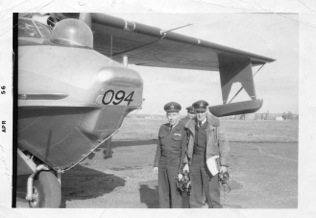CANSO FLYING
I was transferred to RCAF Station Sea Island, now Vancouver International Airport to attend Canso Flight Training School, aka Boat School in 1955.
RCAF Canso’s (PBY-5A’s) at that time were modified from wartime configuration. Most were stripped of the bow turret, which was replaced with a “clipper” bow.
A round hatch in the bow then could be covered with a flat glass plate or a glass bubble.
Post-war military Canso’s required a minimum of 3 crew, pilot, copilot and engineer as engine controls were situated in the tower, between the wing and fuselage. Additional crew when on operations included a navigator, radio operator and crewman.
Initial training at Sea Island involved ground handling and circuits. Approaches and landings took getting used to as the a/c was renowned for swinging a bit under that long, high lift wing and huge rudder.
After a number of hours on type, we flew each day from Sea Island to Pat Bay where during the 2nd WW there had been a PBY-5 base next to the Victoria airport.
Here, monitored by an RCAF crash boat, we undertook water training. “Circuits and splashes” included aerial water surface checks, then visual approaches and water landings under light to moderate wave action which provided depth perception.
Water manoeuvres involved the use of differential engine power, drogues deployed from the blisters and if necessary, with undercarriage down. Later water training included approaching and tying to moorings (bent many a hook by approaching too fast), and anchoring.
These manoeuvres meant that a crewman had to climb out of the bow hatch and stand on the narrow bow ledge after securing the rope to the a/c Beaching required a very slow angled approach into wind, (u/c down if necessary) with engine power reduced by “blipping” the magnetos. The inshore wing and float was elevated by the weight of a crewman with a rope on the outboard wing. When the inshore wing was swung over the beach and, hopefully, when the a/c was fully stopped, the crewman was to run over to the inboard wing to plant the float on the “beach”. The crewman then jumped off the wing and secured the a/c.
Also practised was ramping i.e. approaching from the water and taxiing up the ramp to the airport.
Later we undertook JATO (Jet – assisted take off) training with 2 bottles, each good for 14 seconds of thrust, on each side forward of the blisters. This was only practiced a few times (once in Vancouver harbor where bottles were jettisoned!).
High speed taxiing involved powering the a/c up onto the step then throttling back.
Glassy water landings involved choosing the compass heading of clear landing path. The pilot went on instruments at about 300 feet or so, with the a/c in landing configuration. The copilot maintained a lookout for any floating objects in the landing path.
Two other types of water landings were described but not practised for obvious reasons. Semi-stalls, used to land in very choppy waters involved dragging the rear step just in the water then stalling the a/c. Full stall water landings, stalling just above the water surface, were to be undertaken only under emergency conditions when water conditions were extremely rough because of likely a/c damage.
On operations with cargo sliding doors on Canso’s, water manoeuvring had to be accomplished with differential power, rudder and under carriage as drogues could not be used. Search and Rescue Canso’s were equipped with blisters.
11024 Flights
My first flight on 024 was logged for an air-test while on 102 S&R Flight.., Trenton in Nov 1957. The next flight was a search for a missing civil aircraft at Lac Simon, Quebec that was unsuccessful. Some 52 years later, divers found this a/c in the lake.
My total flight time on 024 was 48 hrs and 15 min., which encompassed much local flying including water work as well as flights to various locations in Ontario.
Peter Austin-Smith (aka Pete Smith)
